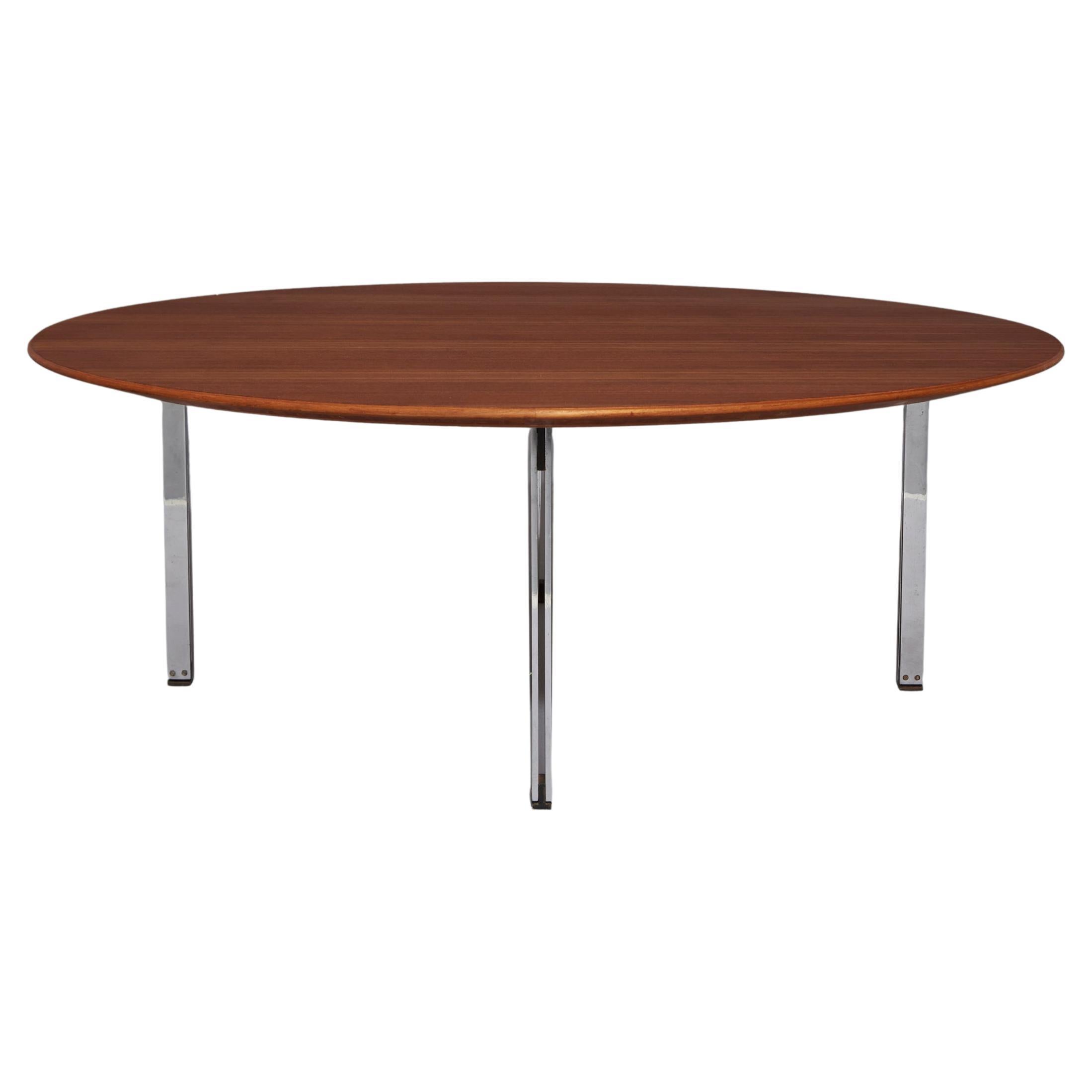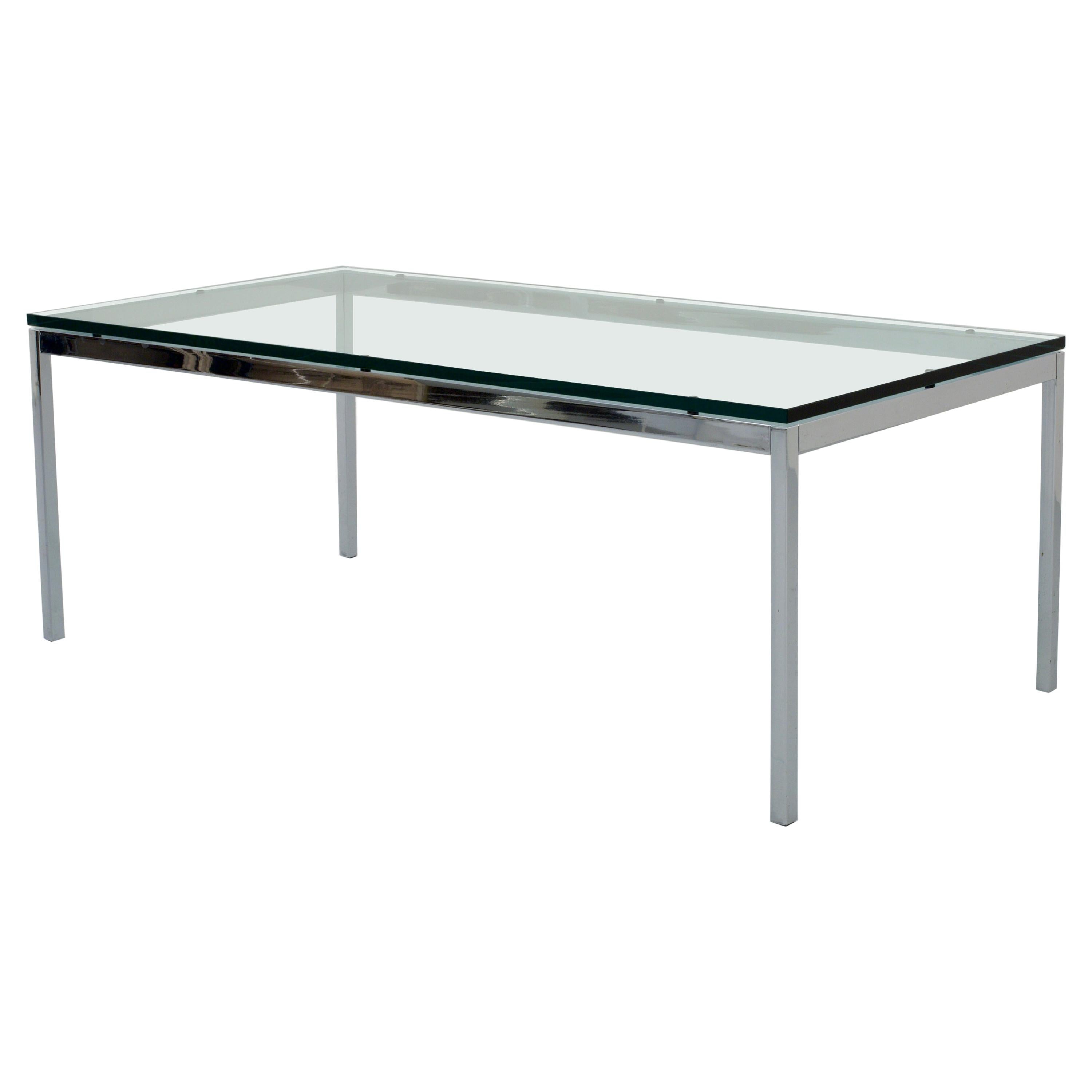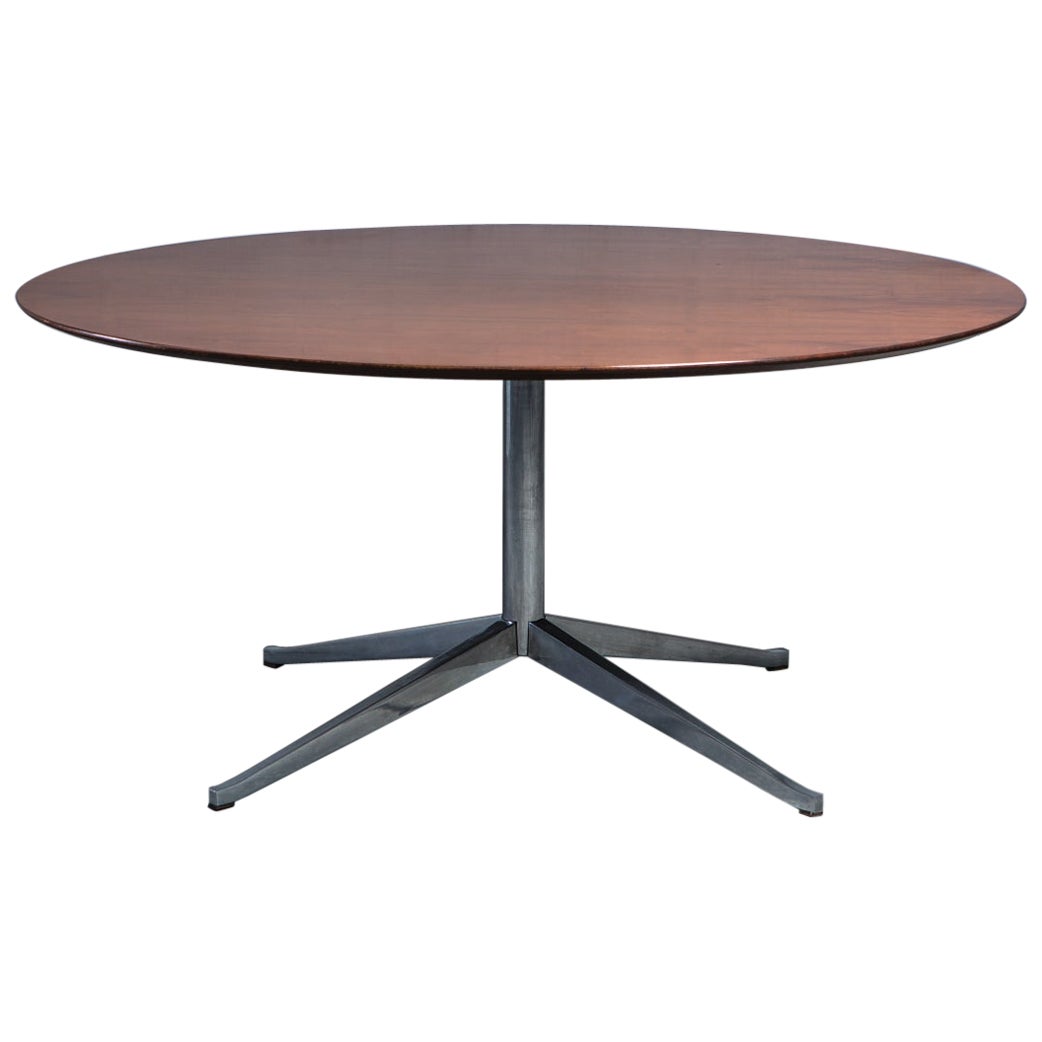Florence Knoll Round Low Table in White Marble and Metal by Knoll 1950s Italy
About the Item
- Creator:Knoll (Manufacturer),Florence Knoll (Designer)
- Dimensions:Height: 15.75 in (40 cm)Diameter: 42.13 in (107 cm)
- Style:Mid-Century Modern (Of the Period)
- Materials and Techniques:
- Place of Origin:
- Period:
- Date of Manufacture:1955
- Condition:Wear consistent with age and use.
- Seller Location:Montecatini Terme, IT
- Reference Number:1stDibs: LU5304221176352
Florence Knoll
Architect, furniture designer, interior designer, entrepreneur — Florence Knoll had a subtle but profound influence on the course of mid-century American modernism. Dedicated to functionality and organization, and never flamboyant, Knoll shaped the ethos of the postwar business world with her polished, efficient design and skillfully realized office plans.
Knoll had perhaps the most thorough design education of any of her peers. Florence Schust was orphaned at age 12, and her guardian sent her to Kingswood, a girl’s boarding school that is part of the Cranbrook Educational Community in suburban Detroit. Her interest in design brought her to the attention of Eliel Saarinen, the Finnish architect and head of the Cranbrook Academy of Art. Saarinen and his wife took the talented child under their wing, and she became close to their son, the future architect Eero Saarinen. While a student at the academy, Florence befriended artist-designer Harry Bertoia and Charles and Ray Eames. Later, she studied under three of the Bauhaus masters who emigrated to the United States. She worked as an apprentice in the Boston architectural offices of Walter Gropius and Marcel Breuer; Ludwig Mies van der Rohe taught her at the Illinois Institute of Technology.
In 1941, she met Hans Knoll, whose eponymous furniture company was just getting off the ground. They married in 1946, and her design sense and his business skills soon made Knoll Inc. a leading firm in its field. Florence signed up the younger Saarinen as a designer, and would develop pieces by Bertoia, Mies and the artist Isamu Noguchi. Her main work came as head of the Knoll Planning Group, designing custom office interiors for clients such as IBM and CBS. The furniture Florence created for these spaces reflects her Bauhaus training: the pieces are pure functional design, exactingly built; their only ornament from the materials, such as wood and marble. Her innovations — the oval conference table, for example, conceived as a way to ensure clear sightlines among all seated at a meeting — were always in the service of practicality.
Since her retirement in 1965, Knoll received the National Medal of Arts, among other awards; in 2004 the Philadelphia Museum of Art mounted the exhibition “Florence Knoll: Defining Modern” — well deserved accolades for a strong, successful design and business pioneer. As demonstrated on these pages, the simplicity of Knoll’s furniture is her work’s great virtue: they fit into any interior design scheme.
Knoll
As a company that produced many of the most famous and iconic furniture designs of the 20th century, Knoll was a chief influence in the rise of modern design in the United States. Led by Florence Knoll, the firm would draw stellar talents such as Ludwig Mies van der Rohe and Eero Saarinen into its compass. Their work would help change the face of the American home and office.
The company was formed in 1938 by the German immigrant Hans Knoll. He first worked with his fellow ex-pat, the Danish designer Jens Risom, who created furniture with flowing lines made of wood. While Risom served in World War II, in 1943 Knoll met his future wife, Florence Schust. She had studied and worked with eminent emigré leaders of the Bauhaus, including Mies, Walter Gropius and Marcel Breuer. She won Knoll over with Bauhaus notions of industrial arts, and an aesthetic that featured flat and tubular metal frames and angular forms. When Hans died in a car crash in 1955, Florence Knoll was appointed head of the company. It was as much through her holistic approach to design — a core division of the firm was dedicated to planning office systems — as Knoll's mid-century modern furnishings themselves that she brought about the sleek and efficient transformation of the American workplace.
Today, classic Knoll furnishings remain staples of modern design collections and decor. A history of modern design is written in pieces such as the elegant Barcelona chair — created by Mies and Lilly Reich — Saarinen’s pedestal Tulip chair, Breuer’s tubular steel Wassily lounge chair and the grid-patterned Diamond chair by Harry Bertoia.
As you can see from the collection of these designs and other vintage Knoll dining chairs, sofas and tables on 1stDibs, this manufacturer's offerings have become timeless emblems of the progressive spirit and sleek sophistication of the best of modernism.
- ShippingRetrieving quote...Ships From: Florence, Italy
- Return PolicyA return for this item may be initiated within 7 days of delivery.
- Gio Ponti Round Coffee Table in Walnut Wood Italian Manufacture 1950sBy Gio PontiLocated in Montecatini Terme, ITRound coffee table realized in walnut wood with metal details, the tabletop presents an elegant circular decorative motif. Attribuited to Gio Ponti, Italian manufacturer from the 1950s Gio Ponti was an icon of the modernist movement: the Italian designer, architect, artist and publisher contributed significantly to the worlds of architecture and design with his extensive work in fine furniture and ceramics, education, office and residential buildings, and everything in between. Giovanni, known as Gio Ponti was born in 1891 in Milan. It was there that he spent his childhood, and in 1921 he began to study architecture at the Politecnico di Milano. From 1923 to 1930 he served as the artistic director of the Richard-Ginori porcelain factory. In 1927, Ponti started his first architectural office, together with Emilio Lancia, and in 1928 he started the magazine Domus, which is still regarded as one of the most influential European magazines for architecture and design. He was also very influential during the period as a curator of the Milan Triennale. After his collaboration with Emilio Lancia had come to an end, upon completion of the Torre Rasini, he began to work as an architect together with the engineers Antonio Fornaroli and Eugenio Soncini...Category
Vintage 1950s Italian Mid-Century Modern Coffee and Cocktail Tables
MaterialsMetal
- Franco Albini TL30 Round Table in Metal and Wood for Poggi Pavia 1950s ItalyBy Poggi, Franco AlbiniLocated in Montecatini Terme, ITRound table model TL30 with black lacquered metal base and a wooden top. Designed by Franco Albini for Poggi, Pavia in 1950s. After spending his childhood and part of his youth in Robbiate in Brianza, where he was born in 1905, Franco Albini moved with his family to Milan. Here he enrolled in the Faculty of Architecture of the Polytechnic and graduated in 1929. He starts his professional activity in the studio of Gio Ponti and Emilio Lancia, with whom he collaborates for three years. He probably had his first international contacts here In those three years, the works carried out are admittedly of a twentieth-century imprint. It was the meeting with Edoardo Persico that marked a clear turning point towards rationalism and the rapprochement with the group of editors of “Casabella”. The new phase that that meeting provoked starts with the opening of the first professional studio in via Panizza with Renato Camus and Giancarlo Palanti. The group of architects began to deal with public housing by participating in the competition for the Baracca neighborhood in San Siro in 1932 and then creating the Ifacp neighborhoods: Fabio Filzi (1936/38), Gabriele D’Annunzio and Ettore Ponti (1939). Also in those years Albini worked on his first villa Pestarini. But it is above all in the context of the exhibitions that the Milanese master experiments his compromise between that “rigor and poetic fantasy” coining the elements that will be a recurring theme in all the declinations of his work – architecture, interiors, design pieces . The opening in 1933 of the new headquarters of the Triennale in Milan, in the Palazzo dell’Arte, becomes an important opportunity to express the strong innovative character of rationalist thought, a gym in which to freely experiment with new materials and new solutions, but above all a “method”. Together with Giancarlo Palanti, Albini on the occasion of the V Triennale di Milano sets up the steel structure house, for which he also designs the ‘furniture. At the subsequent Triennale of 1936, marked by the untimely death of Persico, together with a group of young designers gathered by Pagano in the previous edition of 1933, Franco Albini takes care of the preparation of the exhibition of the house, in which the furniture of three types of accommodation. The staging of Stanza per un uomo, at that same Triennale, allows us to understand the acute and ironic approach that is part of Albini, as a man and as a designer: the theme addressed is that of the existenzminimum and the reference of the project is to the fascist myth of the athletic and sporty man, but it is also a way to reflect on low-cost housing, the reduction of surfaces to a minimum and respect for the way of living. In that same year Albini and Romano designed the Ancient Italian Goldsmith’s Exhibition: vertical uprights, simple linear rods, design the space. A theme, that of the “flagpole”, which seems to be the center of the evolution of his production and creative process. The concept is reworked over time, with the technique of decomposition and recomposition typical of Albinian planning: in the setting up of the Scipio Exhibition and of contemporary drawings (1941) the tapered flagpoles, on which the paintings and display cases are hung, are supported by a grid of steel cables; in the Vanzetti stand (1942) they take on the V shape; in the Olivetti store in Paris (1956) the uprights in polished mahogany support the shelves for displaying typewriters and calculators. The reflection on this theme arises from the desire to interpret the architectural space, to read it through the use of a grid, to introduce the third dimension, the vertical one, while maintaining a sense of lightness and transparency. The flagpole is found, however, also in areas other than the exhibition ones. In the apartments he designed, it is used as a pivot on which the paintings can be suspended and rotated to allow different points of view, but at the same time as an element capable of dividing spaces. The Veliero bookcase...Category
Vintage 1950s Italian Mid-Century Modern Dining Room Tables
MaterialsMetal
- Console Table in Black Lacquered Wood and Pink Marble Italian Manufacture 1950sLocated in Montecatini Terme, ITA Mid-Century Modern style console table with a structure in black lacquered wood and a tabletop in pink marble. The console table presents a single drawer on the frontal part. ...Category
Vintage 1950s Italian Mid-Century Modern Console Tables
MaterialsMarble
- Gio Ponti Table in Oak Brass and Red Laminate Italian Manifacture 1950sBy Gio PontiLocated in Montecatini Terme, ITLarge table or desk with structure in oak wood, tabletop in red laminate and brass details. Designe by Gio Ponti, Italian manufacture from the 1950s. Gio Ponti was an icon of the m...Category
Vintage 1950s Italian Mid-Century Modern Tables
MaterialsBrass
- Gio Ponti Coffee Table in Wood and Glass by Figli di Amedeo Cassina 1950sBy Gio Ponti, Figli di Amadeo CassinaLocated in Montecatini Terme, ITCoffee or occasional table with structure in wood a removable center part in sheet metal and a rectangular shaped table top designed by Gio Ponti and produced by Figli di Amedeo Cassina...Category
Vintage 1950s Italian Mid-Century Modern Coffee and Cocktail Tables
MaterialsMetal
- Ettore Sottsass Dining Table in Wood and Black Lacquered Metal by Poltronova 50sBy Poltronova, Ettore SottsassLocated in Montecatini Terme, ITRound dining table or living room table with four legs in black lacquered metal, table top in wood and brass details. The peculiar tabletop presents a beautiful decoration due to t...Category
Vintage 1950s Italian Mid-Century Modern Dining Room Tables
MaterialsMetal, Brass
- Carrara Marble and Chrome Coffee Table in the Style of Florence KnollBy Florence Knoll, KnollLocated in Kansas City, MO36 inch square Carrara marble and chrome coffee table in the style of Florence Knoll. White marble with gray and beige veining. No chips or significant scratches. The chrome is free ...Category
Vintage 1960s American Mid-Century Modern Coffee and Cocktail Tables
MaterialsMarble, Chrome
- Mid Century Florence Knoll Square Coffee Table in WalnutBy Florence Knoll, KnollLocated in Detroit, MIThis vintage Mid-Century Modern Florence Knoll for Knoll Associates, Inc. square wood coffee table is circa 1960 and features a walnut wood top on a steel frame. This iconic table is a mid century modern classic and exemplifies the clean, minimalist design of the period pairing well with a wide selection of design styles from classic mid century modern to contemporary. Original Knoll Associates, Inc. label on underside. Please reach out to us with any questions about this item or for further clarification of shipping options by clicking on the “Ask the Seller...Category
Mid-20th Century American Mid-Century Modern Coffee and Cocktail Tables
MaterialsSteel
- 1950s Florence Knoll Coffee Table in Walnut and Chrome SteelBy Knoll, Florence KnollLocated in Madrid, ESCenter or coffee table designed by Florence Knoll for Knoll international in Walnut wood and Chrome Steel. Excellent vintage condition with slight signs of use, United States, 1950’s...Category
Vintage 1950s American Mid-Century Modern Center Tables
MaterialsSteel
- Florence Knoll Coffee Table in Glass and Chrome, USA, 1970sBy Florence KnollLocated in Amsterdam, NLThis coffee table was designed by the famous American designer Florence Knoll (1917-2019). Florence Knoll was based in the U.S. with the design agency 'Knoll International'. The tabl...Category
Vintage 1970s North American Mid-Century Modern Coffee and Cocktail Tables
MaterialsChrome
- Walnut Round Dining Table by Florence Knoll for Knoll InternationalBy Florence Knoll, KnollLocated in Chiavari, LiguriaStunning and very rare round dining or conference table by Florence Knoll has a versatile diameter of 160cm. It has a solid walnut top and a chrome-plated steel base. Produced in the...Category
Vintage 1960s American Mid-Century Modern Dining Room Tables
MaterialsStainless Steel
- Florence Knoll Marble + Chrome Coffee TableBy Florence Knoll, KnollLocated in Brooklyn, NYMake iconic mid-century modern design the focal point of any room with this exceptional marble & chrome cocktail table by American design legend Florence Knoll. Originally conceived ...Category
Mid-20th Century American Mid-Century Modern Coffee and Cocktail Tables
MaterialsStone, Marble, Metal, Chrome
Recently Viewed
View AllRead More
10 Trailblazing Female Designers
From pioneering visionaries to contemporary talents, get to know some of the most important women in design.
Remembering Design Visionary Florence Knoll Bassett (1917-2019)
A loving look back at the life and career of a doyenne of mid-century-modern style, who died last week at the age of 101.







